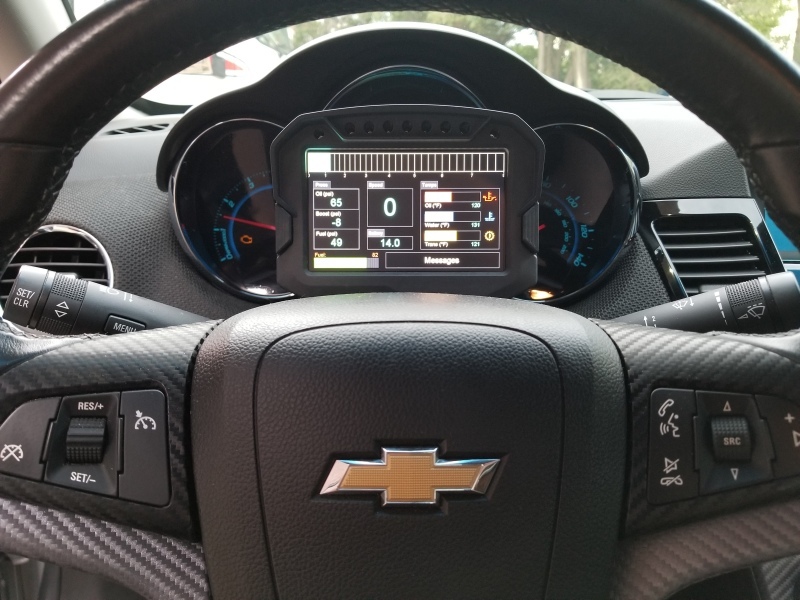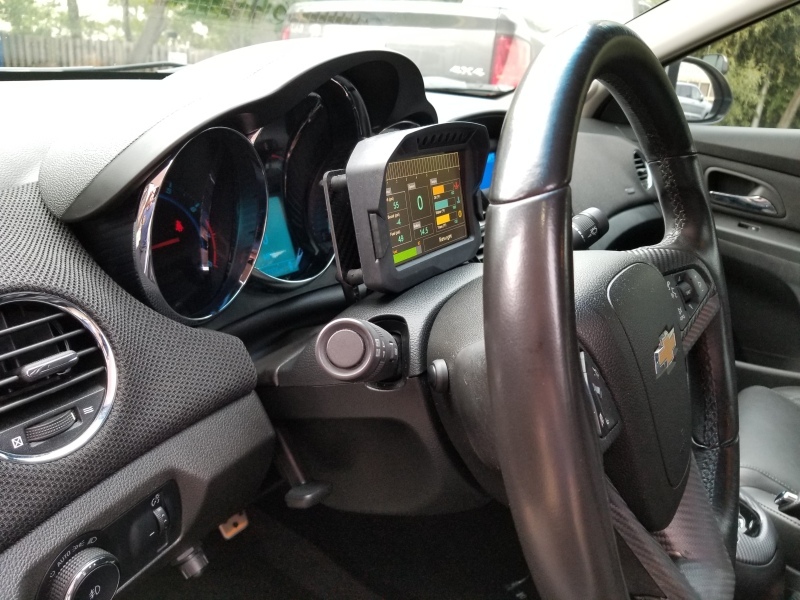Spending all this money on engine upgrades for a Chevy Cruze doesn’t make sense in itself, I can admit that, but not having a way to monitor certain parameters and warn of potential issues after spending all that money also doesn’t make sense. I learned a lot from working with the engineers when I was racing, and the easiest and most effective way, in my opinion, to monitor engine parameters is with a digital dash display. The driver can easily see what’s important all on one screen, and it can be programmed to alarm when anything is outside the set parameters.
Digital dashes do cost a good bit of money, but I think the functionality and the compactness of the system make it worth the investment. I may have said it before, but I have a mild case of OCD and clutter is one thing that really bothers me. I think individual gauges look nice when they are mounted and displayed in a way that looks clean and like it was meant to be there. The only issue for me is that I would like to monitor quite a few things, and the more gauges, the more cluttered the interior looks to me, which triggers my OCD.
Anyway, that’s my justification for purchasing a digital dash display. The next step was determining which one to purchase. There are many options on the market, but after comparing several different brands and models, I decided on the AEM CD-5. It’s a compact size and completely customizable. The software has preloaded templates but you can also design your own look and configure the screens to suit your needs. It connects easily to the car via the OBDII port and is also expandable with other AEM modules and sensors through the AEMnet CAN Bus. If you don’t know what a CAN Bus is, I’ll leave that for you to research on your own. It also has logging capabilities to log any parameters you choose.
Through the ODBII port, you can use a scan tool to see certain parameters made available by the manufacturer called PIDs. The available PIDs differ from car to car and manufacturer to manufacturer. You’re basically at the mercy of the manufacturer and can only see whatever they choose to let you see through the OBDII port. The AEM dash can be configured to display whatever PIDs are available through the port. It’s a very quick and easy way to see certain temperatures and pressures that aren’t displayed on your car’s OEM dash.
I was able to see some good parameters such as the actual water temp, transmission temp, battery voltage, intake air temps, and quite a bit more. Some of the things I couldn’t see, which I wanted to see, were oil temperature and oil pressure to name a few. Unfortunately, the Cruze doesn’t have an oil temp sensor or an oil pressure sensor. It has an oil pressure switch, which turns on the low oil pressure indicator light when the oil pressure drops below whatever pressure the switch is calibrated to. As for oil temperature, the ECU calculates a theoretical temperature based on other sensor data. No worries, though; I can easily add any sensor I would like and connect it to an AEM sensor module for the dash to see.
The installation can be very quick and easy If you choose. The display can be installed and removed as needed, but that means visible wires and mounts. Visible wires through my eyes are viewed as clutter, and I think I covered that earlier. I don’t like clutter, especially wires, so I planned out all the wire routing and built my own harness to make the installation of the dash and sensors permanent and clean.
I mounted it on the steering column shroud behind the steering wheel. That’s where the one in my race car was mounted and it’s very easy to see and doesn’t take a lot of eye movement back and forth between it and the road. I cut a mounting bracket from a piece of carbon fiber plate and used aluminum tabs to secure it to the shroud. The only issue with mounting it in that location, which isn’t really an issue, is that it blocks the view of the OEM speed and tach gauges. It isn’t really an issue because those PIDs are available through the OBDII and can be displayed on the AEM dash.
Overall, I was impressed with the dash, and I think the features it has and the ability to expand the system make it a worthwhile investment for the project.
DS







